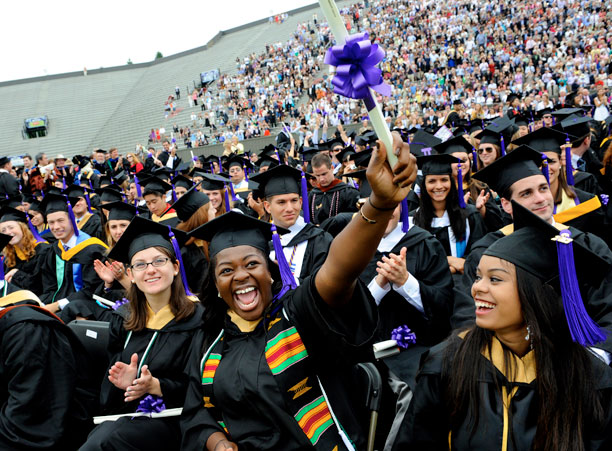What job can a liberal arts major find after college? Actually, it might be easier to ask, what job can’t a liberal arts major do after college?
Year after year, research shows that liberal arts majors are not only very employable — and even preferred by many employers because of their well-rounded education and critical thinking skills — but graduates holding liberal arts degrees are also increasingly paid comparatively well.
Graduates of the College of the Holy Cross particularly fare well, both in terms of the level of their starting pay and in the variety of job opportunities available to them.
Consider research conducted recently by the Career Planning Center of Holy Cross, together with independent research conducted by the National Association of Colleges & Employers (NACE):
Starting pay above average
For 2012 graduates of the College of the Holy Cross, based on a response rate of 83 percent of the class, the average starting salary was $43,650. That’s higher than the average starting salary that NACE reported for liberal arts graduates nationally ($43,100). Holy Cross’ average starting pay is also above NACE’s findings for Math & Sciences ($42,471) and Humanities & Social Sciences ($36,988) graduates nationally.
Mid-career pay even more impressive
Holy Cross graduates fare even better over time. In a study of mid salaries of bachelor degree graduates, PayScale.com ranked Holy Cross No. 7 among all liberal arts schools, and No. 21 among all types of schools nationally. The mid-career median salary for Holy Cross graduates was $107,000.
Industrious grads
The industries in which recent Holy Cross graduates are employed are also wide and varied. Financial services, education and health care are far and away the top Holy Cross employers, followed by communications/media, government/law, accounting/professional services and technology. But 15 other industries also employ significant numbers of Holy Cross grads, spanning architecture to scientific fields.
Grad school cool, too
Graduate school is another path commonly pursued by Holy Cross graduates. Fifteen percent of the Class of 2012 is now pursuing their masters, law degrees or Ph.D.s. Notably, Holy Cross consistently has one of the highest acceptance rates of its graduates to medical/dental schools and law schools — 82 percent and 85 percent, respectively.
Others above all else
Of course, average starting pay and graduate school acceptance rates are only a few indicators of successful college outcomes. A substantial number of Holy Cross grads find fulfillment in serving others — not coincidentally a core value of Jesuit education. Nearly 7 percent of the Class of 2012, or 47 students, are now providing full-time service work, predominantly for the Jesuit Volunteer Corps and AmeriCorps. Which raises another point of distinction: Holy Cross consistently leads the nation in the number of its graduates entering the Jesuit Volunteer Corps.
College of the content
Whether entering the for-profit, non-profit or public service sectors, Holy Cross graduates tend to be happy. Just ask The Alumni Factor. In its recent national study, Holy Cross ranked No. 2 among all liberal arts schools and No. 5 among all types of schools based on its graduates’ career success, financial success, and overall happiness. “Holy Cross excels at developing graduates who are highly successful, happy and loyal,” reports The Alumni Factor. The College’s “powerful combination of graduate success, happiness, and broad development puts Holy Cross among the country’s elite schools.”
Related Information:
